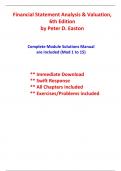Exam (elaborations)
Solutions For Financial Statement Analysis & Valuation, 6th Edition Easton (All Chapters included)
- Course
- Institution
Complete Solutions Manual for Financial Statement Analysis & Valuation, 6th Edition by Peter D. Easton, McAnally, Sommers and Zhang ; 9781618533609. Full Modules included Module 1 to 15. Module 1. Framework for Analysis and Valuation. Module 2. Review of Business Activities and Financial Statemen...
[Show more]



